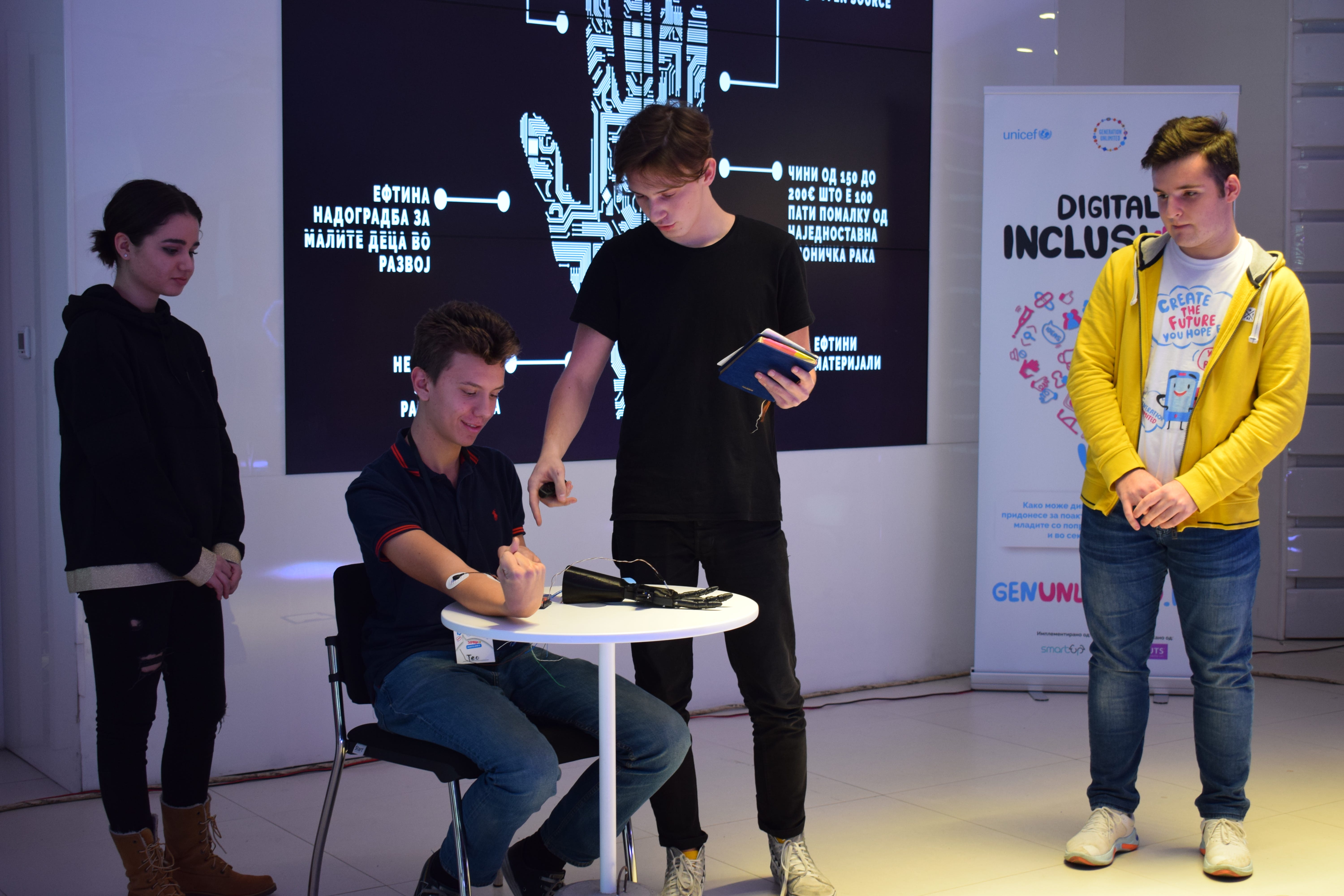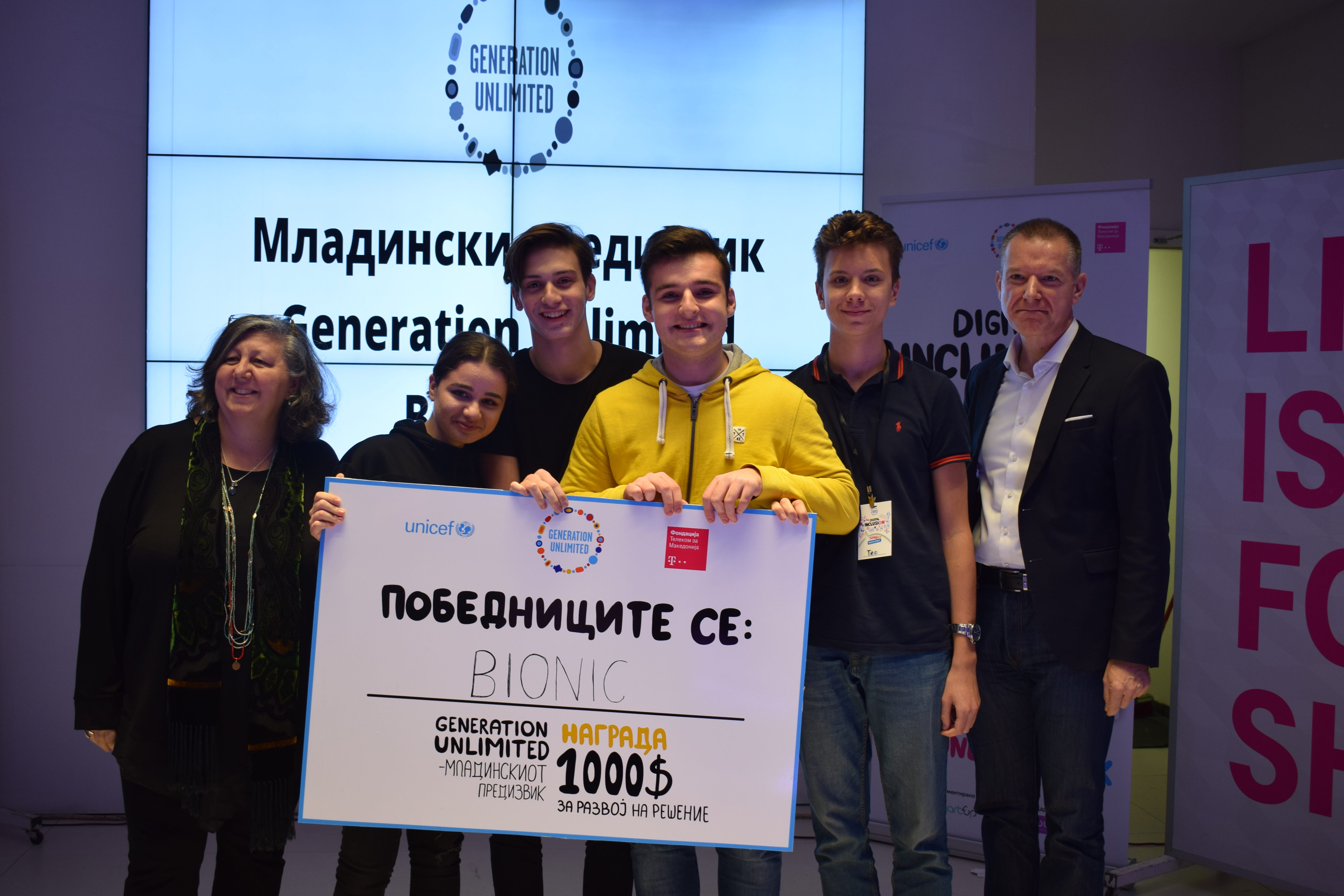In our previous blog, we told you more about how we launched the Generation Unlimited — Youth Challenge in North Macedonia, why the topic of “Digital Inclusion” and how we prepared for the creation of solutions which would help children and youth with disabilities.
In this blog, we invite you to read more about the transformative journey that is the Bootcamp for co-creation, where participating teams used their findings and by working closely with the mentors and facilitator of the challenge managed to shape their solutions.
What was the Bootcamp all about?
The Bootcamp is a three-day “Design Thinking” workshop which aims to inspire ideas, initiate a creative process and give young innovators the resources to produce a prototype of their solutions. At the end of this workshop, 5 teams are selected to proceed in the challenge as finalists, receiving an initial seed-investment and three-month-long mentorship from a dedicated mentor.

Being part of the Bootcamp is an inspiring experience for all, both the participants and mentors!
“The mentors developed leadership skills and gained a personal sense of satisfaction from knowing that they’ve helped someone. The mentees expanded their knowledge and skills, gained valuable advice from an experienced person, and got a chance to build their future professional networks.”
–Aleksandar Lazovski, project manager, SmartUp
On the first day, the teams were solely focused on coming up with a clear concept for their solution for the challenge: “How can digital technology contribute to the inclusion of children and youth with disabilities in education and in everyday life?”.

During the second day of the Bootcamp, they continued working on their concept, tweaking and perfecting it so that they could have solid ground on which they would build their digital solutions.
By the end of day two, they had developed prototypes of their hardware and/or software solutions and began preparing for the final presentation of their work which took place on the third and final day.
The change-making initiatives!
We are eager to introduce you to the ten participating teams and for you to learn more about their ambitious projects. Although only 5 out of the the 10 teams advanced to the next phase, it is important to recognize that each and every team devoted a lot of work, research and passion to their projects and strived to come up with real solutions to real problems that youth with disabilities face every day.
Throughout the entire process, they manifested great empathy, motivation, problem-solving skills and ability to learn, adapt and include all feedback given from the mentors, facilitators as well as the youth with disabilities who participated in the challenge, in their final products.

On the last day of the Bootcamp, the teams took the stage and presented their prototypes in front of a panel of judges as well as all the participants, mentors and facilitators. These were their golden ten minutes that would later determine which teams would get the unique chance to further develop their project and receive a seed investment of a 1000$ and three-month-long mentorship support.
Without any further ado, we present to you this years #GenU teams and their marvellous solutions!

“From Zero to Hero”
The project purpose is to develop an intelligent wheelchair which will significantly help people with physical disabilities to use their wheelchair more independently and safely. By controlling the wheelchair with eye movement, the person using it is in no need for assistance from other people. In addition, the wheelchair is going to include a health monitoring system and will give real-time reports on the person’s health by using multiple sensors integrated into the wheelchair so that the person and their caretakers can easily detect health problems or indicators of changes in overall well-being.

“Digital Heartbeats”
The mobile application “Eye for me” helps people with damaged sight in completing everyday tasks and activities more easily. The team decided on offering the following functionalities: Locating the person using the app via GPS, providing directions by using the location and camera, object detection for safer mobility and 24-hour emergency assistance. This way, people with damaged sight could commute and travel without the need of assistance, just by using “Eye for me”.

“Bionic”
Their goal is to make a bionic arm with all of its usual functions which will have a smaller number of components from the existing options and it will be available as an Open Source to the public which means that anyone who needs a bionic arm can choose and customize the size of the arm, download the free models for 3D printing from the Internet, print the construction on a 3D printer, order the electronic parts and produce it fully, without any previous experience, within 3 to 4 hours. Unlike the available option on the market which can cost up to 100.000 €, their final product can be printed out with a fraction of the price varying around 100–150 €.

“UNICO”
Recognizing the need for equal learning opportunities, the team came up with the idea of making a mobile application that would help fill the gap for adapted educational materials for children with mild intellectual disabilities. The application includes multiple games and activities for the students and documents the students progress so that parents, teachers and defectology experts can assess the results and help the child advance easily.

“PortComSign”
The team is developing a mobile app called “WeCom”, whose main functionalities provide translation for easier communication between people with damaged hearing and those without. By using the device’s camera, screen and microphone, the app helps people communicate by translating speech or text to sign language and sign language to speech or text. This is made possible by integrating an entirely new system which includes speech recognition and videos of sign language.

“Сајбер Извидници” (Cyber Scouts)
As their target group for this solution, the team chose children and youth with ASD (autistic spectrum disorder). They came up with the idea of a mobile application that could be used on a tablet, something that children and youth with ASD usually have with them most of the time, which provides pictures representing various objects and activities that the user might want to have or needs at a certain moment, but cannot communicate to people around them. By providing visuals of essentials used in every-day activities like going to school or using the bathroom, children and youth with ASD can point and show their wishes and needs easily and discreetly, eliminating their struggle to communicate.

“Нешто Нетипично” (Something Unusual)
In order to help children with disabilities and their parents, this team is developing a website and mobile app that parents can use to find a suitable volunteer who will assist their child in every-day activities. Primarily for children with intellectual disabilities, this platform provides a great solution for parents who don’t have the resources to hire an assistant. By giving the parents the option to choose the date, time and volunteer it gives them full control and assurance that their child will be accompanied at the appropriate time and place by a trained professional.

“Mind Benders”
People with different types of disabilities can find it difficult or unpleasant to take part in some every-day activities like going out to dinner. Facing the challenge of understanding and ordering off the menu, this team has developed a mobile app which will adapt menus of bars and restaurants in the appropriate form, so that people with damaged sight, damaged hearing, people who are dyslexic or those with autistic spectrum disorder can independently and easily use. This is going to help people enjoy their meals without any misunderstandings or help.

“Инфинити” (Infinity)
Speech impairment is something that many children and young people with Down syndrome struggle with when communicating. This team solves this problem by introducing an application which helps children and youth with DS practice their pronunciation on several levels. Starting off with the alphabet, the user says each letter into the microphone of the device after which the application evaluates their pronunciation, motivating them to try again or move on to the next letter. There are several levels that follow: practising syllables, words and finally, sentences. By creating a profile on the app, users can track their improvement, the application can be used continuously and parents, assistants and defectology experts can get valuable information on the improvement.

“Unstoppables”
Team Unstoppables believes in equal access to information and services through the Internet for all. With this in mind, they ventured out to create an online platform which adapts the view and functionalities to suit the needs of people with different types of disability with a single click on a website. Named “Enable”, the platform includes adapted information and access to various public services and information for people with damaged sight, damaged hearing, autistic spectrum disorder and dyslexia.
And the results are in!
It was the last day of the Bootcamp and the last point on the daily agenda. The decision on which teams would be progressing forward in the challenge was made by applying the international criteria of the #GenU Youth Challenge. After a detailed look through the proposed projects and solutions final score was concluded by including the scores from the judges, mentors and the participants themselves.
We all gathered around in anticipation as the final scores were handed to the facilitator. With great pleasure, Мs Bogeva took the stage and announced the teams which would receive a seed investment of a 1000$ and three-month-long mentorship support:








